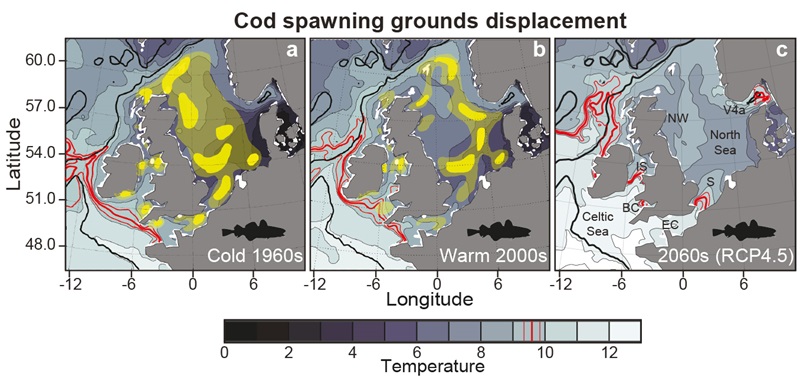Some Like it Cool
According to recent multi-disciplinary, international research, cod in the Celtic Sea, Bristol Channel, and English Channel will disappear in the next few decades if climate change continues at the same pace and magnitude as today, with Irish Sea cod being at risk over a slightly longer period.
The reason for this is a strict upper temperature threshold for cod spawning. The situation is less severe in the cooler North Sea, but thanks to the unique, long-term Continuous Plankton Recorder datasets we know that suitable prey for cod larvae has been displaced northwards over recent years. For Northeast Arctic cod, extensive survey data suggest that longer spawning migrations, and therefore higher migration energy costs, are an issue in the Barents Sea. Thus, due to climate change, different ‘weak links’ seemingly exist, depending upon cod habitat.
It was by coincidence that we were able to clarify the worrying status of southern cod populations in warmer water. In experiments at the headquarters of the Institute of Marine Research (IMR) in Bergen, Norway, pairs of female and male Atlantic cod were held together in a series of spawning chambers to study aspects of their reproduction. In 2000–2002, the research focused on how Northeast Arctic cod respond to different food levels. However, this experiment entirely failed because the cod either did not release any eggs at all or spawned highly irregularly, especially towards the end of the experiments. I put ring binders with 3 years of detailed notes on my office bookshelf—to stay there for good, seemingly.
Nearly two decades later, the increasing awareness of the consequences of unprecedented ocean warming led to a sudden realization of the value of these monitoring datasets on individual pairs of cod. It appeared that this experiment coincided with the highest sea temperature in the Northeast Atlantic since 1900. This was confirmed in the inlet water to the spawning chambers, which showed a pronounced ‘heatwave’ in 2002, up to 2°C warmer than normal. On closer examination of the data, we saw that the spawning (ovulation) cycle of cod became erratic at 9.6 (±0.25) °C. In addition, the female continued with this odd behaviour even if the temperature later decreased—a significant point, given that each female cod normally spawns 15–20 times per season. This is a strategy called batch production and is seen in many species of fish.

Figure 1. Displacement of cod spawning grounds in the southern distribution area, with the 9.6 (±0.25) °C borderline inserted along with the corresponding hindcasted (a and b) and forecasted bottom temperatures in March (c). Panel a and b refers to the cold 1960s and warm 2000s, respectively, whereas panel c to the predicted temperature fields in 2060 based on the RCP4.5 scenario. Yellow = location of spawning grounds. BC = Bristol Channel, EC = English Channel, IS = Irish Sea, NW = Northwestern North Sea subarea, S = Southern North Sea subarea, and V4a = Viking 4a (northeastern) North Sea subarea. From Kjesbu, O. S. et al. (2023).
There was no trace of any adaptation to higher temperatures; indeed, earlier reports on farmed cod held in communal tanks had documented significantly lower egg fertilization rates at and above the same upper temperature that we had recorded. Moreover, extensive tagging programmes using temperature recorders show that cod consistently avoid spawning temperatures ‘somewhere’ between 8 and 10°C. Collectively, these findings point at something extremely fundamental, likely imprinted in the genes. Research in years to come will hopefully pinpoint the precise cause.
Taken together, this information implies that southern populations of cod, i.e. in the Celtic Sea, Bristol Channel, English Channel, and the Irish Sea, will encounter reproductive problems when this physiologically determined 9.6°C borderline gradually moves northwards (see Fig. 1).
• Olav Sigurd Kjesbu (olav.kjesbu@hi.no)
Principal Scientist, Department of Marine Environment and Resources, Institute of Marine Research, Bergen, Norway.
Further reading
Kjesbu, O. S. et al. 2023 Latitudinally distinct stocks of Atlantic cod face fundamentally different biophysical challenges under on-going climate change. Fish and Fisheries. 24(2): 297-320. doi:10.1111/FAF.12728
